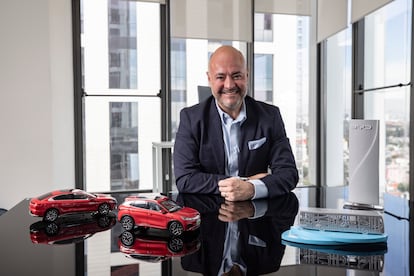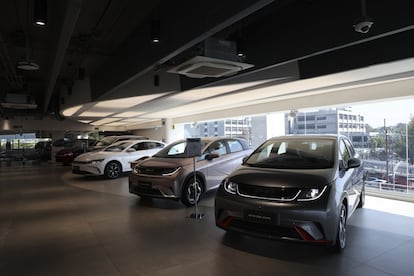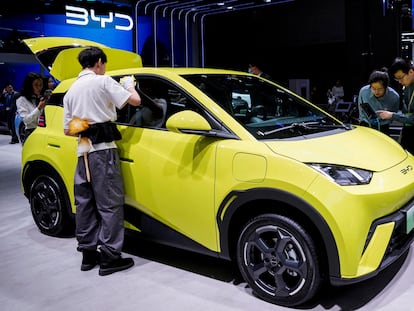Jorge Vallejo, general director of Chinese auto company BYD: ‘We want to democratize the use of electric cars in Mexico’
The executive says that construction of a plant with the capacity to produce 300,000 vehicles will begin this year. The firm is continuing to analyze the best spot for this new factory

The Chinese automotive Build Your Dreams (BYD) has stepped on the accelerator in Mexico. Less than two years after its first foray into the country with the sale of imported vehicles, the electric car company has set new, ambitious goals for Mexico. Eight model launches this year, more than 50,000 cars to be sold by 2024 and the BYD’s crown jewel: the construction of a manufacturing plant with capacity to produce up to 300,000 vehicles. Although Chinese executives have not yet revealed how much will be invested in the factory or where it will be located, BYD’s general director in Mexico, Jorge Vallejo, provides some insight on what is on the horizon.
Between meetings with the Mexico City team and upcoming trips to China, Vallejo, 51, makes time in his busy schedule to talk about the plans of a company that boasts — without giving specific sales figures for Mexico — triple-digit growth month after month. When asked about the evident proximity of this new Mexican plant to the U.S. market and future plans to enter the United States, Vallejo insists, time and again, that he is completely focused on consolidating the sales, distribution and production lines in Mexico. “Manufacturing will be 100% focused on the Mexican market,” he says.
Question. After nearly four months as general director of BYD Auto Mexico, how have you approached the position?
Answer. I’m very proud to represent the number one selling brand of new energy vehicles in the world. In this first quarter, I had the opportunity to launch two new models. We launched Song Plus DM-i in January, Mini Dolphin in February, and in April, the King DM-i will be released. And we are already preparing the global launch of a new model. Due to BYD’s vertical integration, we manufacture practically 100% of the product. Except for the windshields and tires, the technology, design and equipment is developed and manufactured by us, which allows us to have an accessible product in the Mexican market. Mini Dolphin is the brand’s most economical vehicle, with a selling price of 350,000 pesos [$21,270].
Q. What are you betting on for your next launch?
A. It is the first PHEV sedan with DM-i technology that is 100% electric. It could be a person’s first car, a vehicle for medium-sized families, a work car, a ride-hailing vehicle and it has a price of around 498,000 pesos [$30,300].
Q. At this dizzying pace, how many models will be launched this year in Mexico?
A. We had planned between six and eight national launches this year.
Q. How many units has BYD sold in Mexico?
A. We are doubling sales month after month. I am growing 100%, month over month.

Q. What do you think is driving the accelerated growth of the Mexican marker?
A. I don’t think it’s just the appetite for an electric car, it’s because of the BYD brand, because of its engineering, design, technology, the quality of the product and its affordability. BYD’s growth worldwide has been overwhelming, we have grown 147.8% in the month of March compared to last year, selling more than 300,000 units per month worldwide, breaking the barrier of seven million new energy vehicles on the market.
Q. What is the progress in car manufacturing in Mexico?
A. As already announced by our boss Stella Li, Mexico will manage a manufacturing plant, with the definitive location likely to be announced in the following weeks or months. We are working to be able to supply the Mexican market. A market that has a universe of 1.5 million annualized units, and we are focused on manufacturing for the Mexican market. This year I am planning to sell 50,000 units in Mexico, opening 50 distribution points nationwide.
Q. What progress is being made to achieve this goal?
A. April is going to be the fastest month of distribution openings. This month, dealerships are being opened in Aguascalientes, two in Monterrey, one in Guadalajara and one in Mexico City, plus the 18 that were already in the works.
Q. It’s been revealed that Mexican states such as Nuevo León are being considered for the site of this manufacturing plant...
A. Yes, we have talked to several states that have the infrastructure, the business environment, the labor force, the training, and we have analyzed, of course, the manufacturing landscape in Mexico.
Q. How much money will be invested in this new plant?
A. I do not have that information, but in our first stage, the plan is to have capacity to manufacture 150,000 units, moving on to a second stage of another 150,000 units.
Q. Will construction of this new plant begin this year?
A. Yes, I’m sure it will.
Q. What will be the challenges to continue with this ambitious sales and manufacturing plan in Mexico?
A. The issue of training, labor and management. That is why we are betting on this country, we believe that Mexico has the necessary qualities in infrastructure, ports, labor and design to allow us to have this growth.
Q. However, the cost of buying an electric car in Mexico is still very high compared to an internal combustion vehicle. Have you considered lowering prices to increase your market share?
A. Lowering prices is no longer possible, we are being extremely aggressive and innovative in terms of positioning and price, and we are not sacrificing other elements such as digital technology, safety, airbags, ABS brakes in order to have an accessible price — all the equipment is involved. Each of our models has meets global safety and design standards and the consumer is seeing this. BYD’s function is to democratize the use of electric vehicles in Mexico, so that we can reach various segments that previously did not have access to an electric car.
Q. At the end of last year, BYD surpassed Tesla in the global sale of electric cars, do you think you will be able to maintain this trend this year?
A. Leadership is not shared, and BYD leadership is here to stay for many years.
Q. Is BYD Mexico interested in sending cars manufactured in Mexico to the United States?
A. Today we are focused on the Mexican market, we are growing at a rapid rate at triple digits month after month, we are doubling sales, we are launching new products. We are focused 100% on the Mexican market both for marketing, the creation of the distributor network and, of course, manufacturing will be 100% focused on the Mexican market.
Q. And in the medium term, you are not interested in entering the U.S. market?
A. We are focused today on the Mexican market; I do not have the capacity to neglect this highly competitive market that has 50,000 units to be delivered. All my energy, all my efforts, are focused on the Mexican market.
Q. What do you think of American manufacturing associations’ claims that there is a risk that Chinese cars will enter the U.S. via Mexico?
A. I have not had time to review the criticism, we are focused on the Mexican market.
Q. Do you plan for BYD Mexico to become an automotive hub for Central and South America?
A. This is likely part of the strategy that the bosses are developing. But the job and the focus they have given me is Mexico: grow in Mexico, develop Mexico.
Q. With that goal in mind, are you worried about Tesla’s plans to open a plant in Santa Catarina, Nuevo León?
A. Any brand that pushes new technology, design and management forward is more than welcome, and I think BYD’s technology is incomparable.
Q. Do you think the Mexican government needs to introduce incentives to increase the use of electric cars in Mexico?
A. You have to understand that it is a new business model that can not only be accompanied by a fiscal, administrative or economic incentive. I would instead look at the accessibility of charging stations, both in residences and in buildings.
Sign up for our weekly newsletter to get more English-language news coverage from EL PAÍS USA Edition
Tu suscripción se está usando en otro dispositivo
¿Quieres añadir otro usuario a tu suscripción?
Si continúas leyendo en este dispositivo, no se podrá leer en el otro.
FlechaTu suscripción se está usando en otro dispositivo y solo puedes acceder a EL PAÍS desde un dispositivo a la vez.
Si quieres compartir tu cuenta, cambia tu suscripción a la modalidad Premium, así podrás añadir otro usuario. Cada uno accederá con su propia cuenta de email, lo que os permitirá personalizar vuestra experiencia en EL PAÍS.
¿Tienes una suscripción de empresa? Accede aquí para contratar más cuentas.
En el caso de no saber quién está usando tu cuenta, te recomendamos cambiar tu contraseña aquí.
Si decides continuar compartiendo tu cuenta, este mensaje se mostrará en tu dispositivo y en el de la otra persona que está usando tu cuenta de forma indefinida, afectando a tu experiencia de lectura. Puedes consultar aquí los términos y condiciones de la suscripción digital.
More information
Archived In
Últimas noticias
Alain Aspect, Nobel laureate in physics: ‘Einstein was so smart that he would have had to recognize quantum entanglement’
Imelda Castro, the woman who wants to rule the cartel battleground of Sinaloa
The new victims of the Republican war on Obamacare: Millions hit by soaring health insurance premiums
A country divided on migrant rights: Some US states expand protections while others restrict them
Most viewed
- David King, chemist: ‘There are scientists studying how to cool the planet; nobody should stop these experiments from happening’
- Reinhard Genzel, Nobel laureate in physics: ‘One-minute videos will never give you the truth’
- Oona Chaplin: ‘I told James Cameron that I was living in a treehouse and starting a permaculture project with a friend’
- Sinaloa Cartel war is taking its toll on Los Chapitos
- Mexico completes its trade shift with the entry into force of tariffs on China and countries without trade agreements











































